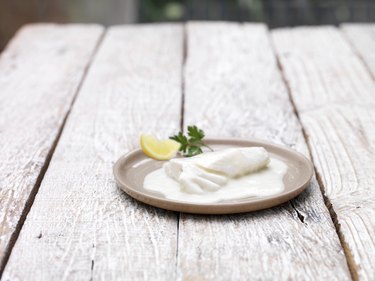Traditionally, whitewash was the combination of hydrated lime or slaked quicklime and other materials, ranging from egg whites or Portland cement to even milk. Its purpose was to create a paint that was not fully opaque and provide protection to bare wood. Today, it's possible to create a whitewashed effect on paneling, furniture and other materials simply by brushing on a mixture of paint and water.

Video of the Day
How to Whitewash Paneling
To whitewash wood or faux wood paneled walls, you should begin by sanding the surface. Since paneling tends to be smooth, creating a rougher surface can go a long way towards helping the paint to stick. Try a 220-grit sandpaper to get started.
Video of the Day
Next, clean the walls to remove any dust from sanding and dirt that has accumulated over time. You can use a bucket of warm water with dish detergent or any number of specialty products designed for cleaning paneling. Once the walls have dried, you may wish to prime them. If you do, use an oil-based primer for best results. If you'd like your whitewash to lend a different look, you can also use a bleach and water solution on the walls before proceeding rather than priming. This will whiten the brown of the paneling but still leave some pigment behind, whereas primer will cover the brown completely.
To whitewash your paneling, prepare a half-paint, half-water solution and apply it directly with a paintbrush. This is a messy project so have plenty of rags handy to mop up excess water. Once the walls have dried, assess whether you are satisfied with the level of coverage. You can always attempt a second layer of whitewash to change the look.
How to Whitewash Furniture
To whitewash furniture, use any water-based paint and add water in a 1:1 ratio. It isn't necessary to use white paint, though. Other colors can be used to vary the look of your finished product. You can also start with a layer of colored paint beneath your whitewash to give the piece a unique style.
Clean your furniture before beginning and be sure it is completely dry. Then, brush on your paint and water mixture. Use rags to dab the whitewash dry where necessary. Once you've finished painting, let the furniture dry. After it has done so, assess whether you'd like to add another layer of whitewash.
How to Whitewash Brick
Brick is another material that is often whitewashed, both when it is used on a building's exterior and when it's an interior accent, such as around a fireplace. To whitewash brick, you will want to use a latex-based paint rather than a water-based paint.
Before you begin, you should wash the brick and all grout or mortar thoroughly using a scrub brush and trisodium phosphate. Rinse the brick with water and let it dry completely before proceeding. If the brick has been painted in the past, fix any chips and reprime it before you move forward with whitewashing.
Next, mix equal parts latex paint and water in a container. Ensure that they have an even consistency. Use a spray bottle to apply this mixture to the bricks. A cloth that has been moistened with the whitewash mixture should then be used to spread out the whitewash on the brick. Use a brush to access divots or hard-to-reach places in the brick. Let the area dry thoroughly.